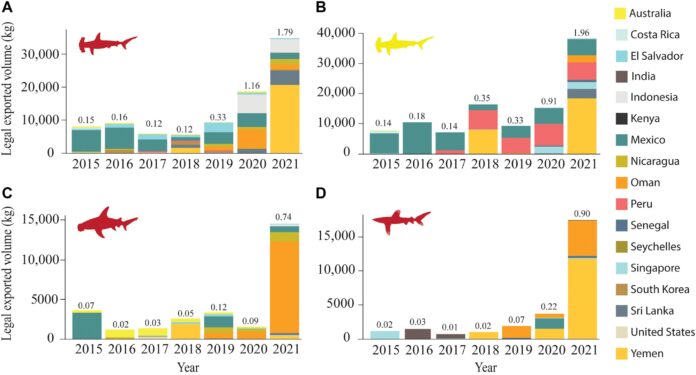Despite more than a decade of international efforts to protect threatened shark species, a new study reveals that the illegal trade of shark fins remains widespread and persistent across the globe. Research led by marine biologists Diego Cardeñosa of Florida International University and Demian Chapman, director of the Shark and Rays Conservation Research Program at Mote Marine Laboratory & Aquarium, highlights a significant disconnect between regulations and reality.
The Scale of the Problem
The study, published in Science Advances, focuses on Hong Kong, a major hub for the shark fin trade. Researchers discovered that fins from 4 out of 5 shark species regulated under the Convention on International Trade in Endangered Species (CITES) are routinely found in Hong Kong markets, despite minimal legal trade being reported since 2014.
The genetic analysis uncovered alarming disparities. The study found that there were 70 times more fins from oceanic whitetips and 10 times as many hammerhead fins than would be expected based on legal reporting.
CITES Regulations and Their Limitations
In 2013, the global community recognized the severity of the issue and imposed trade regulations on five particularly vulnerable shark species – three large hammerhead species (scalloped, smooth, and great), the porbeagle, and the oceanic whitetip. These regulations require that all trade is reported and certified to ensure it doesn’t threaten species survival.
However, the researchers noted that “there’s a huge gap between what’s on paper and what’s happening in the real world.” CITES Appendix II listing of these species allows trade only if it is legal, traceable, and sustainable. Yet, a majority – 81% – of countries that export shark fins have never reported any trade in these listed species, strongly suggesting ongoing illegal exports.
Methodology: Tracking Fins Through DNA Analysis
The study analyzed trade records and performed extensive DNA analyses on nearly 20,000 shark fin samples collected from markets between 2014 and 2021. This genetic tracking has revealed that the illegal trade spans continents and involves numerous major fishing nations. The research team flagged several countries suspected of high-level involvement in the illegal shark fin trade, including Spain, Taiwan, the United Arab Emirates, the Philippines, Ghana, and Brazil.
The Threat to Shark Populations and Ecosystems
Hammerhead and oceanic whitetip sharks are classified as either critically endangered or vulnerable by the IUCN Red List. Their ongoing exploitation poses a critical threat, pushing populations closer to collapse. Cardeñosa warns that “we are reaching a major tipping point where, if the fishing and trade of these species is not meaningfully reduced, then these sharks will disappear.” This loss of vital top predators could destabilize marine ecosystems, leading to unpredictable and potentially harmful consequences for humans.
Call for Stronger Action
The study’s authors are urging the international community to take stronger action, calling for enhanced enforcement of CITES compliance mechanisms, greater transparency in trade, and expanded genetic monitoring throughout the supply chain. Chapman concludes that “shedding light on this problem is a major step toward solving it,” and emphasizes the need for more stringent measures, such as the possibility of a global trade ban on the oceanic whitetip shark, which will be considered by CITES in December. The findings underscore the urgency of addressing illegal practices to safeguard vulnerable shark populations and protect the health of our oceans.
























